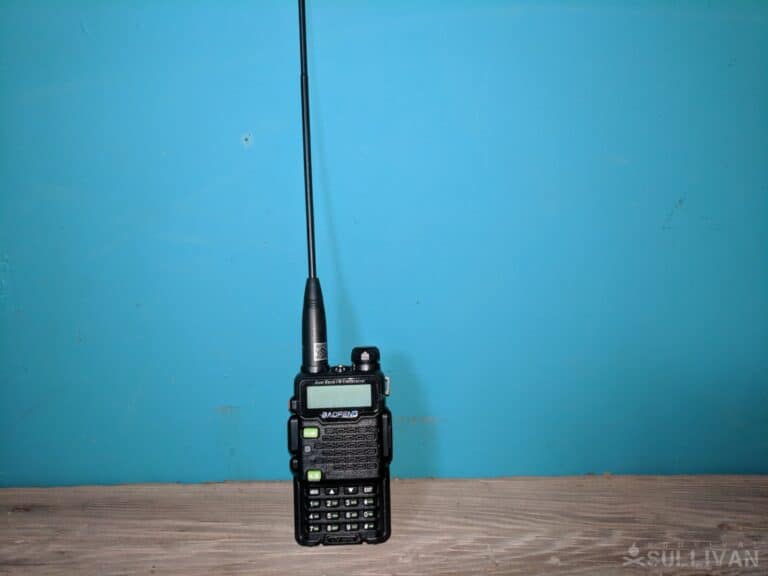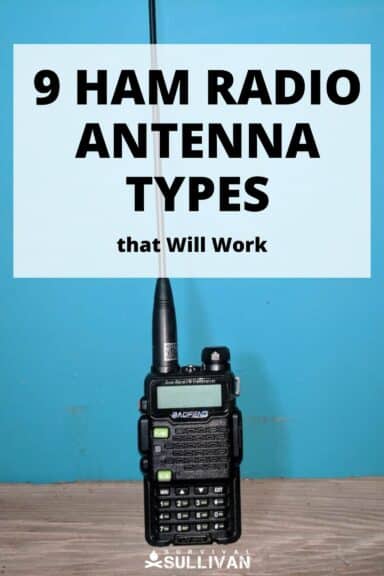Any radio, no matter how good and how powerful, is only going to be as good as its antenna. The antenna is what’s responsible for both propagating and receiving radio signals so that you can send to other stations over the airwaves and also so that you can hear them.

a Baofeng UV 5R5 HAM radio
And ham antennas come in many different varieties suitable for different purposes, from lightweight, flexible, and adaptable antennas that are ideal for mobile use to large, fixed, directional models suitable for maximizing range when DXing.
No matter what your goals are, there’s an antenna out there that’s right for you. I’ll tell you about nine different ham radio antenna types below.
Mobile Antennas
If you are carrying a handheld, or handy-talkie, or using a portable rig and a backpack or even mounted to your vehicle, mobile-type antennas are what you want. Consider the following varieties.
“Rubber Duck”
This is the basic, springy, short antenna that usually comes as standard equipment on handy-talkies and other small, portable ham sets. As a rule, these are only good for short-range communication, but they are convenient, compact, and low profile.
Typically, these antennas will have a helical wire inside that rubbery casing, and although they might do the job for basic functionality, you should definitely consider upgrading to get the most out of your set…
There is almost no ham radio out there that will not benefit from an upgraded antenna, even if it’s a cheap radio to begin with.
Sometimes all you need is a longer version of the same antenna to significantly increase performance.
Roll-Up
Roll-up antennas, also known as roll-up J-poles, are a great intermediary option for handhelds and portable sets that can dramatically increase range and transmission clarity.
They come in a variety of form factors that are designed to be rolled up, as the name suggests, to keep them compact and make them easy to carry, transport, and store.
Generally, they are unfurled and then hung from a convenient nearby structure like a tree, pole, or a purpose-built mast. These offer a great combination of performance and portability, making them ideal for backcountry activities and emergency use.
Magnet Mount
Magnet Mount antennas are exactly what they sound like, antennas of any given size that mount to the roof or other metal point on a vehicle – through the use of powerful magnets so that vibration, bumps, and impacts won’t dislodge them. They typically wire into the radio set via a coaxial cable.
The great thing about magnet mounts is that they do not require any permanent modification of the vehicle, and can be attached and detached very quickly without risking damage to your bodywork. They also come in a variety of sizes which make them suitable for shorter or long-distance communication.
These are a good option if you are just getting into vehicular ham radio. They are ideal for anyone who might need to transfer the antenna between vehicles or need to protect it from theft in the interim.
Lip Mount
Lip Mount antennas are another mobile type, only these typically mount to a seam somewhere on the vehicle’s bodywork, be it between a door and the frame, a hood gap, trunk gap, or somewhere else.
Although performance-wise, they are basically identical to magnet Mount antennas, all things being equal, they offer a trade-off in security versus the likelihood of damage.
They tend to be more secure overall compared to magnet Mount antennas, but if anything impacts the antenna they will tend to warp and damage bodywork because of the leverage they can exert…
This means you’re less likely to lose the antenna under those conditions, but more likely to damage your vehicle! Note that depending on the type of antenna, your vehicle, and the mounting location, the bodywork of the vehicle might induce a little bit of interference.
Base Station Antennas
Base station antennas are designed to be used with larger and more powerful ham radio sets that are kept in a single location, like at your home, place of business, or some other dedicated ham shack.
End-Fed Wire
One of the simplest and most adaptable kinds of antenna, end-fed wire can be set up in all kinds of ways, either hung up from a pole, tree, mast, or another tall place, or lifted into the air by a winch. It can even be strung between two firm points on a slope.
They are extremely easy to install, highly versatile, and a great choice for flexible multi-band operations. As a highly portable type that still offers good performance and the ability to redeploy as needed in emergency situations, they are excellent.
The major downside is that a high-quality antenna tuner is mandatory to reduce impedance which can completely spoil performance. So long as you’re willing to invest in that, you definitely want one of these in your arsenal.
Dipole
The most commonly seen antennas used on ham radio base stations are dipoles. Offering good all-around performance, easy to mount, easy to build, and affordable, they offer reliable performance on a resonant frequency.
However, good performance is generally limited only to that resonant frequency, and for this reason, they are only recommended for ham radio beginners and basic usage.
If you want to stretch your legs with ham, you’ll need a different type of antenna although you’ll always have a place for a dipole when handling basic traffic.
Parallel Dipole
A parallel dipole is a variation of the standard dipole, only it consists of two wires instead of one. They can make a good complementary option for a different resonant frequency as with a standard dipole, but they have most of the same drawbacks, namely that their best performance only comes from a resonant frequency.
However, the design of a parallel dipole makes them ideal for vertical mounting applications where horizontal space might be limited or if you need to mount them in relatively close proximity to other vertically oriented antennas.
Vertical
Vertical antennas are a good step up from dipoles and are one of the most common and popular omnidirectional antennas. With a good ground plane, they are excellent for long-distance calls thanks to their low angle of emission.
However, this advantage is also a weakness: they require a good, clear ground plane for maximum effectiveness.
This isn’t a good antenna choice if you’re dealing with a lot of ground clutter, tall obstacles, or other barriers and don’t have a good repeater network or satellite to make use of.
Yagi / Directional
Directional antennas, often called yagis or yagi-UDAs, are very different from the omnidirectional type we have covered so far.
They can afford users excellent gain and superb range that makes them ideal for long-distance communications and DXing, but a major downside is that they are complicated, bulky, difficult to install, and require lots of fiddling to get dialed in for proper function.
Obviously, if you have high-performance transmitting and receiving from one direction, you’re going to have poor performance transmitting and receiving from all the others.
This means you must have some way to move and aim the antenna precisely unless your radio is for a very specific purpose communicating with another station…
Noise is another problem with these, and different models have different solutions for dealing with it, but this is something you must account for. You might need to invest in more hardware to help reduce noise in order to clean up the signal.
Despite the drawbacks, these are indispensable if you’re doing a lot of work with satellites or repeater systems.

The post 9 Ham Radio Antenna Types that Will Work appeared first on Survival Sullivan.
By: Tom Marlowe
Title: 9 Ham Radio Antenna Types that Will Work
Sourced From: www.survivalsullivan.com/ham-radio-antennas/
Published Date: Mon, 11 Mar 2024 12:48:11 +0000
------------------------
 What is BushcraftSurvival SkillsToolsVideosBushcraft CampsBushcraft KitsBushcraft ProjectsPrivacy PolicyTerms And Conditions
What is BushcraftSurvival SkillsToolsVideosBushcraft CampsBushcraft KitsBushcraft ProjectsPrivacy PolicyTerms And Conditions
